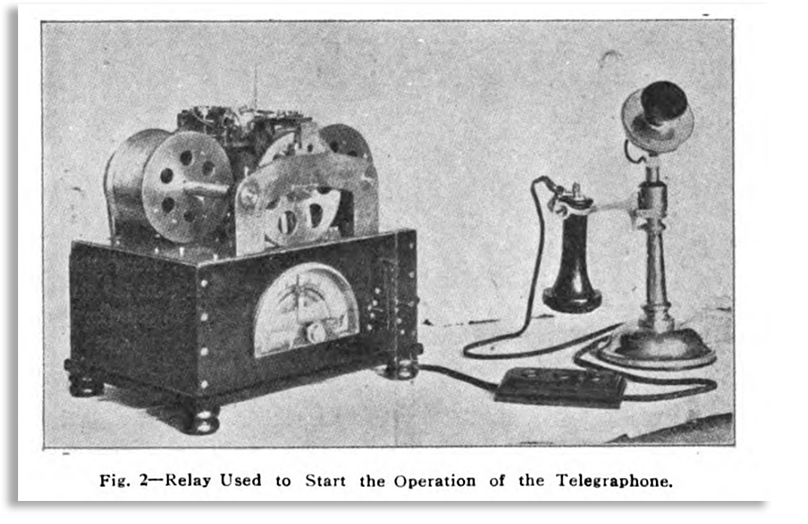Making the Perfect Record
I wrote my dissertation on the intersections between magnetic recording and literary and cultural production from the 1850s to the early 2000s. (I had yet to learn about scope creep.) I revised and published a portion of the diss as an article in issue 85.4 of American Literature, focusing on early magnetic recording experiments (1870s-1930s), including telegraphony (pictured below), and how they unfolded in American radio drama and scientific detective fiction. I concluded that article with a few remarks on what media studies might learn about digital labor today from such histories of sound reproduction, where “the power over how and when to listen demanded the freedom to plausibly deny ever making a record in the first place” (see the article’s last page).
Various links to the American Literature article, titled “Making the Perfect Record: From Inscription to Impression in Early Magnetic Recording,” are below. It’s open access and part of a special issue on “New Media and American Literature,” edited by Tara McPherson, Patrick Jagoda, and Wendy Chun, with contributions from Tara, Patrick, and Wendy as well as Craig Carey, Lauren Klein, Jeff Scheible, Richard Jean So, Gary Hall, Curtis Marez, Jeffrey Shandler, and Steve Anderson.
I composed “Making the Perfect Record” with the Alliance of Networking Visual Culture’s Scalar platform. I used Scalar to integrate audio, image, and video files into my argument and to provide readers with “paths” through the essay. (Choose your own adventure!) Those paths are listed at the bottom of this page. Below I also point to the GitHub repository for the article; Tara, Patrick, and Wendy’s preface for the special issue; related MLab research; and talks I gave during the 2010s on magnetic recording and/or writing with Scalar. Alongside these talks, I had the privilege of facilitating invited workshops on Scalar at Northeastern, Kansas, Syracuse, St. Lawrence, and UW Seattle, among others.
Many thanks to Tara, Wendy, and Patrick for editing “New Media and American Literature” and to Tara (Lead PI), Erik Loyer (Creative Director), Craig Dietrich (Information Design Director), Steve Anderson (Critical Commons and Archive Liaison), and the rest of the award-winning Scalar team for their feedback and incredible positive force.

Making the Perfect Record: From Inscription to Impression in Early Magnetic Recording
Published in American Literature 85.4 (McPherson, Jagoda, and Chun eds.) in December 2013 | 13,669 words, plus audio, image, and video files | open access
Links: essay (HTML); preface by McPherson, Jagoda, and Chun (HTML); repository for the essay (GitHub); website for the ANVC Scalar project (HTML); related MLab research on magnetic recording (HTML); talks at Hawaiʻi, Nebraska-Lincoln, and Hamburg (HTML)
About “Making the Perfect Record”
Intended for audiences across the intersections of literary criticism and comparative media studies, this essay highlights how magnetic recording was affiliated with permanent, immaterial sound during its first six decades (1870–1930). Oberlin Smith (1878) initially framed it as a scratch-free alternative to Menlo Park recording methods and Edison’s tinfoil phonograph. That is, magnetic recording “impressed” sound; it did not “inscribe” it. Later, Valdemar Poulsen’s research on the telegraphone, including his demonstration of it at the 1900 Paris Exhibition, suggested that even then magnetic recordings could be erased and re-impressed, affording at once the immaterial and material, impermanence and permanence. However, the telegraphone was an economic failure in the United States and Europe. Intended as a mechanism for writing the voice from a distance, it was reduced solely to military use by 1917.
Nevertheless, author and amateur criminologist, Arthur B. Reeve, did write about the telegraphone during the 1910s and 1920s. Spanning magazines, cartoons, film, and radio, Reeve’s incredibly popular science fiction detective tales didactically introduced audiences to the presumably magical features of the relatively unknown telegraphone, mixing technical specifications with paranoia about the infallibility of forensic science and disembodied voices forever recorded on wire. With Reeve’s work in mind, this essay demonstrates how, despite the telegraphone’s economic failure, the magnetic aura of permanent, immaterial sound still gained traction in consumer markets well before tape in the 1940s. Through the use of the Scalar platform, the essay unpacks the often ignored, pre-1940s history of magnetic recording, with particular attention to how—through an interweaving of print fiction, sound transduction, and visual culture—early magnetic recording materialized. In so doing, it offers scholars of both new and old media a sense of how we might better historicize the simultaneous permanence and immateriality of contemporary computing cultures. (Read more.)
Project Paths and Sections
- About (HTML): one page
- Essay (HTML, with audio, image, and video files): 30 pages
- Notes (HTML): 60 pages
- Media (HTML, with audio, image, and video files): 33 pages
- Acknowledgments (HTML): one page
- Technical Information (HTML): one page
- References (HTML): one page
Featured image and main image of a telegraphone from “Making the Perfect Record,” published in American Literature 85.4 (2013). Provenance for main image. Provenance for featured image, later edited in Photoshop. I created this page on 6 August 2019 and last updated it on 30 January 2022.